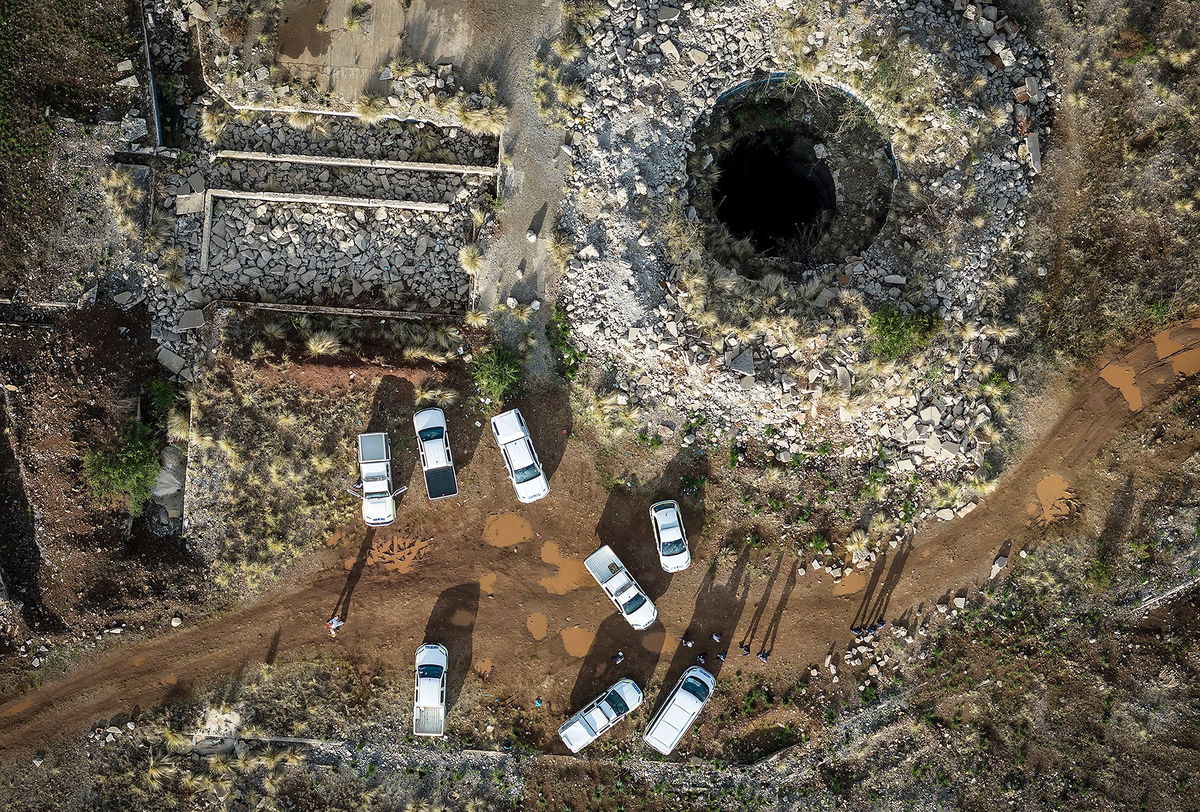Hundreds of illegal miners holed up in disused shaft in South Africa. Here’s what we know

An aerial view of a mine shaft where an estimated 4
By Nimi Princewill, CNN
(CNN) — Several hundred people are believed to remain in an illegal mine in South Africa after the government cut off vital supplies and refused to help them, in a dramatic bid to crack down on the industry.
Food and water supplies to those underground have been halted by police seeking to force the illegal miners to come to the surface.
Ilegal miners can travel up to 4 kilometers underground and spend months below ground in old mines, according to a report by South Africa’s Minerals Commission. But without supplies, conditions are believed to be deteriorating underground.
Reports vary as to how many miners were in the abandoned gold mine in the North West province. North West police spokesperson Sabata Mokgwabone told the Associated Press that three miners who had come to the surface indicated that up to 4,000 miners could be underground. Other police reports said the number in the mine was in the hundreds.
Family members gathered near the mining site on Thursday afternoon, telling Agence France-Presse they were worried about relatives who were still underground.
“We are here for our brothers and sisters, and my husband is here, he has been eight months underground,” Ntomboxolo Qwanti told the AFP.
What is the condition of the miners?
Police spokesperson Athlenda Mathe told reporters that food and water supplies to those underground had been halted. “We are stopping and preventing food and water to go down there as a way of forcing these illegal miners to resurface because what they are doing is criminality,” she said.
One decomposed body was brought to the surface on Thursday, police spokesperson Mathe said, adding that pathologists were at the mine in Stilfontein.
David Van Wyk, a lead researcher at Johannesburg-based Benchmarks Foundation that monitors mining and corporate social responsibility told CNN that the miners could be in a critical condition.
“At this point, they are starving, becoming dehydrated, and breathing toxic dust. They’re going to come out very weak and ill when they do come up,” he said.
South Africa’s Federation of Trade Unions (SAFTU) said it was “extremely concerned” that the situation “may end in a tragedy.”
“Cutting off food and water supplies — with what can only be described as malicious intent, a vindictive act — without a strategy for directly and indirectly engaging with these mineworkers is not helpful,” the union said in a statement Friday.
A community member, Emily Photsoa, also told the AFP that more miners could die “if they don’t get medication and water to sustain them.”
“We are bleeding with them,” she added.
How did we get to this situation?
According to SAFTU, South Africa harbors up to 100,000 artisanal miners, known locally as “zama zamas” with most of the minerals derived from artisanal mining “sold to the black market, and international illicit mineral traders.” It blamed the government for failing to regulate the mining sector.
Van Wyk attributed the spike in illegal mining to the thousands of abandoned mines left unclosed by large-scale companies and multinational corporations.
“We’ve got about 6,000 abandoned mines in the country. They don’t close them as the law requires, so they break the law by not closing and rehabilitating these mines,” he told CNN.
He added that retrenched workers from the abandoned mines “have no other recourse” or extra skills, “so they go down the mines and do the only thing they are capable of doing, which is working in those mines.”
Police have been escalating attempts to stamp out the activity of illegal miners, with more than a billion dollars lost to illegal mining in South Africa annually, according to the country’s Minerals Council.
The blackmarket trade in gold has also fueled violent turf wars, according to a parliamentary brief, as the nation grapples with one of the world’s highest murder rates.
What could happen next?
The Minister in the Presidency, Khumbudzo Ntshavheni, said on Wednesday that no help would be given to the illegal miners.
“We are not sending help to criminals. We are going to smoke them out,” she said.
Speaking to state media, Mametlwe Sebei, who heads the General Industries Workers Union of South Africa, criticized Ntshavheni’s comments, warning that that approach “is almost criminalizing” those in the mine, “many of whom are just poor desperate people.”
The illegal industry often takes place in “horrific conditions” and under the control of organized crime syndicates, Sebei said.
According to Mathe, the police spokesperson, at least 1,172 illegal miners have so far surfaced voluntarily amid the pressure campaign.
Mathe also said locals are organizing a community-led attempt to extract the remaining miners, but would be required to indemnify the police first.
“Community members are stepping in and demanding to go and rescue these illegal miners themselves. We are making them sign indemnity forms as a way of exempting us. We have taken them through the dangers and consequences of doing so,” she said.
Police and defense officials are due to visit the scene on Friday. A police statement said the intention was to “reinforce the government’s commitment to bringing this operation to a safe and lawful conclusion.”
The-CNN-Wire
™ & © 2024 Cable News Network, Inc., a Warner Bros. Discovery Company. All rights reserved.